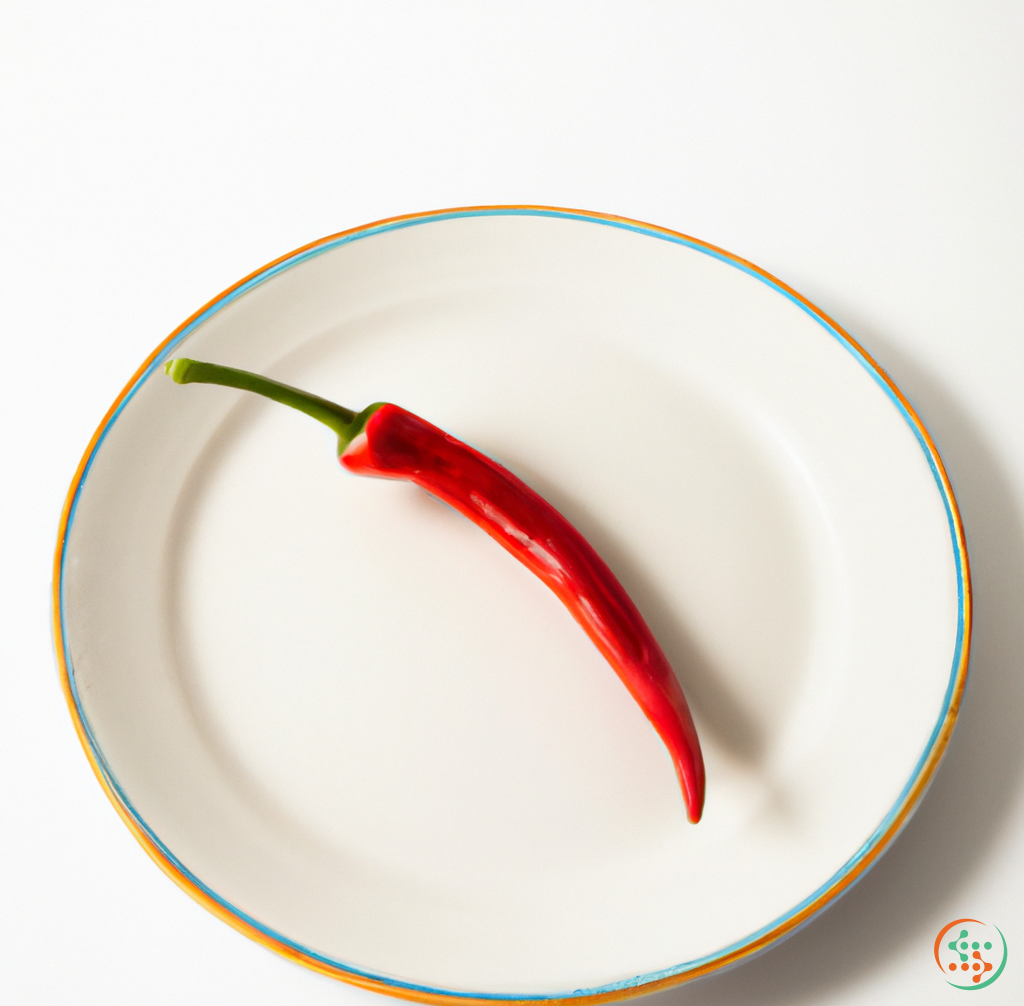Hot Chili Pepper
When one thinks of a hot chili pepper, they usually imagine a red or orange-colored vegetable, associated with the heat and spiciness found in many meals. As pungent as it is, the hot chili pepper is much more than just a condiment to spice up your favorite dishes. What many don’t realize is that these vegetables are both symbolic and medicinal, providing a variety of health benefits and even cultural significance.
The hot chili pepper belongs to the plant genus, Capsicum, which includes peppers and chilis with varying degrees of pungency and sweetness. The cultivation of chili peppers originated from the Central and South America regions, but their use is now found around the globe. The peppers are commonly used to provide zest and flavor to meals across many cultures, such as Mexican, Indian, Chinese, and Italian dishes.
The peppers vary in shape and flavor depending upon their species, but the most popular ones for their heat include the jalapeño, habanero, Thai, poblano, and tabasco chili peppers. The hotter varieties pack the most punch when it comes to spice levels, which is measured on the Scoville scale. Each pepper contains a distinct blend of compounds, such as capsaicin, which provides their trademark heat and pungency, along with their antioxidant and anti-inflammatory components.
For those who don’t appreciate a lot of spice, the milder Bell pepper can provide the same vegetation benefits without the burn. But why add this vegetable to your diet at all? Hot chili peppers offer several health benefits, which may include weight loss, better metabolism, strong immunity, and improved heart health.
Chili peppers are rich in vitamins and minerals; vitamin A, C, K, iron, copper, and magnesium, just to name a few. These micronutrients supply the body with the essential nutrients needed for proper functioning. The capsaicin present in the peppers causes thermogenesis, resulting in more calories burned during digestion. The high fiber content can also reduce appetite, leaving you feeling fuller and less inclined to overindulge later in the day. In addition, the antioxidant properties in chili peppers can help protect the body against free radicals and lower cholesterol levels, further reducing the risk of heart disease and stroke. Chili peppers also contain capsaicin, which has long been used to treat a variety of conditions, such as headaches, muscle aches and pain, and sinus congestion.
Not only are chili peppers beneficial to your health, they also play an important role in many cultures. In Latin American countries, chili peppers are used during celebrations such as Dia de los Muertos, Carnivals, and Christmas, while they are often a symbol of luck or fortune in the East Asian culture. In India, it is believed that eating chili peppers can help one connect with their inner self.
Overall, the hot chili pepper is much more than just a little zing in your food. This bright and vibrant vegetable has been around for centuries and provides numerous rewards for your health and your heart. No matter how you decide to enjoy this spicy treat, incorporating chili peppers into your meals can only do your body good.
It is safe to say that few ingredients have seen as much recognition for their culinary and medicinal properties as chili peppers. Hot chili peppers are used in cuisines around the world and contain chemical compounds that bring a unique flavor, heat and mouthfeel to whatever dish they are added to. But how exactly do these fiery little fruits end up on our dinner plates? In this blog post, we will explore the life of a hot chili pepper, including the process of cultivation, harvesting, shipping and storage, to better understand what is necessary to bring it from the farm to your plate.
The journey of a chili pepper starts with cultivation. Chili peppers are members of the Capsicum family, a genus of flowering plants in the nightshade family and native to the Americas. Specifically, they are native to regions in Mexico and Central and South America and have been part of the human diet since at least 7500 BCE and likely a part of the diet of other species in the region much longer than that. Today, over 30 species of chili peppers are utilized in food, medicine, and for other applications around the world.
When cultivating chili peppers, specialty varieties require specific environmental conditions to perform the certain desired characteristics of flavor, heat, and color. For instance, when cultivating jalapenos, temperature will play a major role in the heat potential of the pepper. Temperatures between 21-25? and 75-80% relative humidity are necessary for jalapenos to reach their optimum size, color and heat. Furthermore, for optimal growth, jalapenos require six to seven hours of sun daily and soil pH between 6.2 to 6.8.
When developing several acres of chili peppers, or even a few pots of a special variety, inputs are essential that increase the rate of growth and enhance the quality of the resulting produce. When managing insects, the use of biopesticides, beneficial insects, and natural repellents is the recommended way of control. Fertilizing, through the incorporation of compost, manure and/or chemical fertilizers, is necessary to ensure there is sufficient nutrient uptake for the peppers to reach their full potential. Dependent on the size of the space and production goals, the use of conventional or organic seed, mechanical cultivation, and irrigations systems can also be a part of the production process. After all of the inputs are taken — be it a few months or several —, the chili peppers are ready for harvest when they have reached their desired size and color.
Harvesting chili peppers requires knowledge and familiarity of the plants, as the ripeness of different varieties can vary significantly. Generally, chilis will be harvested when they have reached between 3-15 centimeters long, depending on the desired variety. During harvest, the peppers will be cut or pulled from the stem, leaving the stem and calyx intact. Chili peppers will then be sorted into bushels for ease of transport, with a wide yield range of 8-25 kilograms per bushel, depending on the fruit size.
Once harvested, chili peppers can be shipped fresh, frozen, or dried. For local and regional delivery, fresh peppers are the most common form of shipment, with buses and crates being the two primary forms of packaging. When shipment is handled over larger distances, the chili peppers will be either frozen or dried. For frozen peppers, the best results come from flash freezing — freezing the peppers in liquid nitrogen — so that their freshness and flavor stay intact during transportation. Once the peppers have been frozen, they can then be transported in refrigerated trucks. However, if they will be stored frozen, peppers need to first be vacuum sealed before then being loaded into modified atmospheric packaging — or MAP — to extend their shelf life.
Drying chili peppers is a more difficult process that takes time and a higher degree of expertise than freezing. It is often done by air, sun or a combination of both. Depending on the type of chili pepper, different approaches are used to achieve the correct consistency and flavor. For instance, jalapenos will be placed near a source of heat to assist with the drying process. For peppers with thick walls, more indirect heat as well as low humidity are necessary to ensure that the peppers aren’t roasted, losing their color, aroma, and unique flavor.
Chili peppers that are shipped fresh or frozen may lose moisture, vitamins and minerals during the transit process, leading to their eventual rotting or spoiling. Proper storage and occupancy conditions are key to achieving the maximum shelf life from harvested chili peppers. Cool and dry temperature, relative humidity of 68-72%, and minimized exposure to light are ideal for keeping fresh chili peppers for two weeks to one month, depending on the variety. For frozen or dried chili peppers, the same general principles should apply. In addition, the storage environment should be free of odors and oxygen, both of which can affect the flavor, aroma and color of the peppers.
After the proper storage and handling, chili peppers are finally ready to make their journey to your dinner plate. Fresh and frozen chili peppers will be transported to their final destination by truck, where they will either be sold directly to restaurants and grocery stores or repackaged for sale to consumers. Dried chili peppers will usually be ground into powders and packaged in small plastic containers or jars that can be sold at grocery stores.
At this point, you may be asking — how do I know if my chili pepper is fresh or old? The answer partly depends on how you wish to use the chili pepper. When using fresh chili peppers, look for peppers that are firm and full-bodied with no blemishes or discoloration. Dried chili peppers should be reddish-orange in color and not have any yellow or white spots, as spots indicate freezer burn.
In conclusion, we have examined the journey that a hot chili pepper makes from its days of cultivation, to the transportation and storage, and finally to the dinner plate. Specifically, it requires expert cultivation and management, careful harvesting, and proper storage and transport to ensure a chili pepper retains its flavor, aroma and color profile. With the right processes in place, chili peppers can safely make their way from farm to consumer, and provide us with the unique flavor, heat and mouthfeel that chili peppers are loved so much for.
| Vitamin A | 0.048 mg | |
| Beta-Carotene | 0.534 mg | |
| Alpha-Carotene | 0.036 mg | |
| Vitamin E | 0.69 mg | |
| Vitamin K | 0.014 mg | |
| Vitamin C | 0.1437 grams | |
| Vitamin B1 | 0.07 mg | |
| Vitamin B2 | 0.09 mg | |
| Vitamin B3 | 0.00124 grams | |
| Vitamin B4 | 0.0109 grams | |
| Vitamin B5 | 0.2 mg | |
| Vitamin B6 | 0.51 mg | |
| Vitamin B9 | 0.023 mg |
| Calcium | 0.014 grams |
Daily Value 1.3 g
|
| Iron | 0.00103 grams |
Daily Value 0.018 g
|
| Magnesium | 0.023 grams |
Daily Value 0.4 g
|
| Phosphorus | 0.043 grams |
Daily Value 1.25 g
|
| Potassium | 0.322 grams |
Daily Value 4.7 g
|
| Sodium | 0.009 grams |
Daily Value 2.3 g
|
| Zinc | 0.26 mg |
Daily Value 0.011 g
|
| Copper | 0.13 mg |
Daily Value 0.9 mg
|
| Manganese | 0.19 mg |
Daily Value 0.0023 g
|
| Selenium | 0.5 ug |
Daily Value 0.055 mg
|
| Tryptophan | 0.026 grams | |
| Threonine | 0.074 grams | |
| Isoleucine | 0.065 grams | |
| Leucine | 0.105 grams | |
| Lysine | 0.089 grams | |
| Methionine | 0.024 grams | |
| Cystine | 0.038 grams | |
| Phenylalanine | 0.062 grams | |
| Tyrosine | 0.042 grams | |
| Valine | 0.084 grams | |
| Arginine | 0.096 grams | |
| Histidine | 0.041 grams | |
| Alanine | 0.082 grams | |
| Aspartic Acid | 0.286 grams | |
| Glutamic Acid | 0.264 grams | |
| Glycine | 0.074 grams | |
| Proline | 0.087 grams | |
| Serine | 0.08 grams |
| Total Sugars | 5.3 grams |
per 100g
|
| Palmitic acid (16:0) | 0.03 grams |
|
| Stearic acid (18:0) | 0.01 grams |
|
| Total Saturated fatty acids: | 0.04 g | |
| Oleic acid (18:1) | 0.02 grams |
|
| Total Monounsaturated fatty acids: | 0.02 g | |
| Linolenic acid (18:3) | 0.01 grams |
|
| Linoleic acid (18:2) | 0.23 grams |
|
| Total Polyunsaturated fatty acids: | 0.24 g | |







